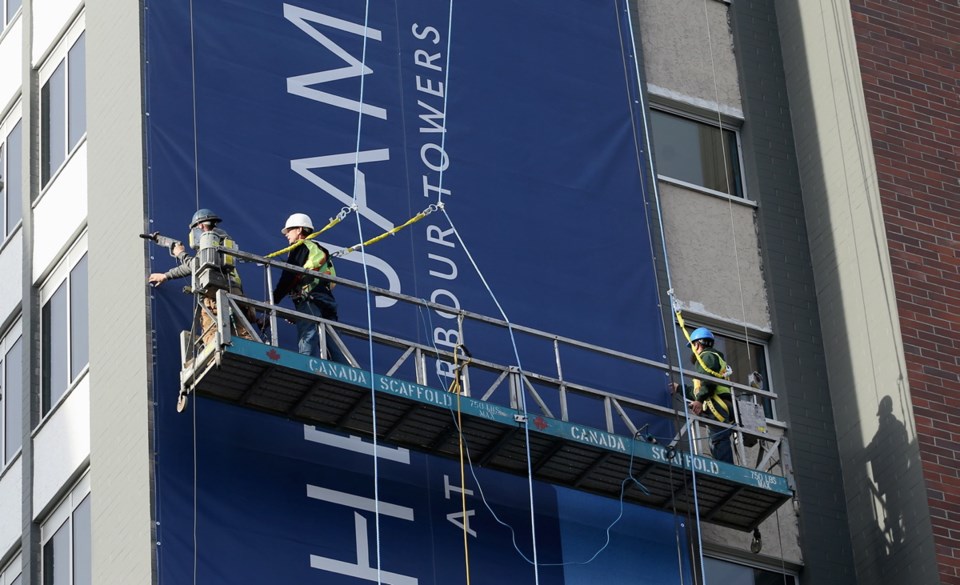Strong demand for affordable housing powered home construction in the capital region in November, according to figures released Monday by Canada Mortgage and Housing Corporation.
There were 242 new homes started last month, compared with 181 in November 2017. Fifty-five were single-family homes and 187 involved multi-family construction.
In the first 11 months of the year in the region, 3,498 homes were started, slightly behind last year’s pace of 3,658 through November.
The vast majority of the construction has featured rental accommodation, with 2,359 new apartments started so far this year. That compares with 2,389 by this time last year.
“Metro Victoria housing starts trended lower in November. However, new apartment construction remained elevated,” CMHC senior analyst Braden Batch said.
Batch said pockets of the region have seen significant increases in rental-housing construction. “Demand for relatively affordable units remains high.”
Central Saanich has recorded the start of 120 new apartments this year, a huge jump from the seven by this point last year. Langford posted 1,198 starts through November, up from 438 in the first 11 months of last year.
Casey Edge, executive director of the Victoria Residential Builders Association, said there has been an obvious shift toward building rental housing in Langford.
Edge said that might reflect the difficulty some builders are expecting to face in municipalities such as Victoria, which have been talking about requiring developers to include affordable housing as part of new construction.
“That could continue,” Edge said. “Builders may look at other municipalities [besides Victoria].
“Clearly, builders are already choosing Langford as a more efficient and cost-effective place to build. Langford is doing close to 50 per cent of all housing starts in the CRD.”
Of the region’s total of 3,498 new homes started this year, 1,633 have been in Langford. By this time last year, the municipality had recorded 927 of the region’s 3,658 new starts.
Edge said builders remain busy and reasonably optimistic about the region, despite a softening of the real estate market.
“Building is still pretty strong despite the fact the mortgage stress test and rising interest rates are having an impact [on homebuyers],” he said.
In all of 2017, home builders started 3,862 new homes in the region — the most since 4,439 were started in 1976.
Construction continues to be driven by strong migration from elsewhere in B.C. and across Canada by retirees or people attracted by the region’s robust and diverse economy.
Edge said there are no signs that will change next year — though he never counts out global issues and economic uncertainty, which can wreak havoc on any economy.
“Next year, I wouldn’t expect we will see a quiet [home-building sector]. When you consider that in an average year we see about 2,200 housing starts, we are at a point where we could drop 1,000 starts and still be seeing very strong numbers historically,” he said.
“There will be a softening, because I don’t see how these kinds of numbers can continue.”
Nationally, the annual pace of 91原创 housing starts picked up in November, beating analyst expectations, and signal that the country’s real-estate market continues to show signs of stability.
CMHC said the seasonally adjusted annual rate of housing starts in Canada was 215,941 units in November, up from 206,753 in October.
Economists had expected an annual rate of 198,000, according to Thomson Reuters Eikon.
The increase in the overall annual rate of housing starts came as the pace of urban starts increased by 2.2 per cent in November to 202,054 units.
The annual rate of urban multiple-unit projects such as condominiums, apartments and townhouses grew 3.9 per cent to 151,596 units. This made up for a decline in single-detached urban starts, which fell 2.3 per cent to 50,458.
“While single-detached starts continued to trend lower in November, this was more than offset by a gain in the trend of multi-unit starts following several months of weakness,” Bob Dugan, CMHC’s chief economist, said in a statement.
Rural starts were estimated at a seasonally adjusted annual rate of 13,887 units, said the housing agency.
TD Economics says the figures weren’t completely unexpected due to the number of new residential permits issued in the third quarter.
Statistics Canada also reported on Monday that the value of residential building permits was $5.2 billion in October, up 4.2 per cent from September. Both multi-family and single-detached permits showed gains.
The agency said the increases in Ontario and B.C., helped offset a decline in Quebec, and was largely driven by permits for apartment and condominium housing.
“On a trend basis, housing starts appear to have troughed, with some upward momentum of late,” said TD senior economist Fotios Raptis in an analyst note.
“Given the upward trend in building permits through October, there’s a good chance that housing starts will continue to see some further upside in the months ahead for both single and multi-family units”
RBC Economics senior economist Nathan Janzen anticipates housing starts to pull back in the new year.
“Looking beyond near-term swings in the data, we continue to think interest rates will continue to rise gradually going forward — and that will weigh particularly heavily on interest-rate sensitive purchases like houses,” Janzen said in a note.
“Higher rates plus regulatory measures have already slowed the home resale market significantly. We expect those trends will ultimately result in slower home building activity next year as well.”
— With files from CP



